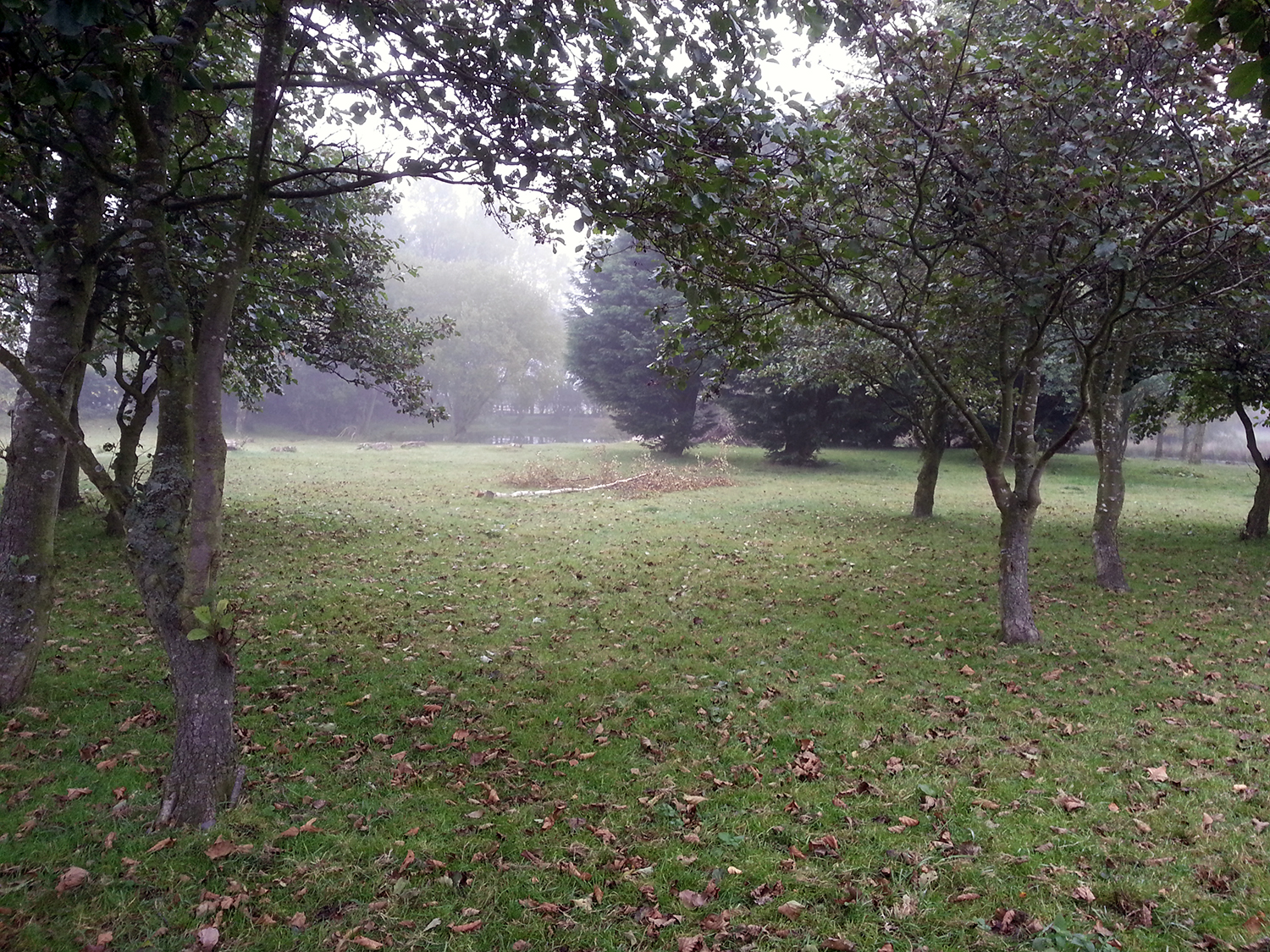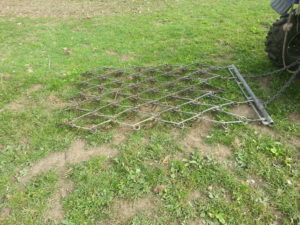By a pony paddock I am referring to a small field used to keep one or more horses or ponies in usually under a couple of acres.
Equipment:
- Chain harrow
- Roller
- Fertilizer spreader
- Quad bike or compact tractor
- Pasture topper
Annual routine:
Once the grass begins to grow in spring, chain harrow the grass and start to feed it, a little at regular intervals over the summer is far more efficient as it reduces the about of fertilizer lost to leaching. As the surface of the grass becomes pitted by the hooves it needs rolling and when the grazing starts to have clumps of course grass and/or weeds go over it with a pasture topper. Any poo picking should be done prior to chain harrowing and pasture topping to prevent it being dispersed over the field.
Rejuvenating a paddock:
Start off by getting a professional soil analysis so you can see what fertilizer and lime the soil needs. While you are waiting for this to come back have a good walk around the paddock and check for drainage problems (often indicated by clumps of course sedge), damaged or missing fencing, the condition of the water supply, check and treat any ragwort and if the grass needs to be cut back with a pasture topper.
How you tackle a drainage problem depends on its course, an isolated area could be a broken or block land-drain which needs to be dug out and repaired, but if on digging down you may find a spring then it needs to be lead away to drain if possible. Excessive damp around a pond could well be caused by the pond overflow being silted up and needing clearing out. Generally, poorly draining land will have to be drained by land-drains which leads the water to somewhere it can be disposed of.
Once you have sorted out these problems you can chain harrow the grass and over-seed the paddock; prior to starting the fertilizer regime recommended by the soil analysis. It will take time for the grass to start to come right and if there are a lot of weeds such as dock and nettle you will have to repeatedly cut them back until they weaken and die out or use a selective weed killer if practical.
Feeding:
The grass being grazed is constantly losing nutrients by several routes: the most important being the removal of the plants by grazing, exasperated by the necessary practice of poo picking to reduce the parasite load, and leaching, as the rain washes the nutrients down out of reach of the plants. As the quantity of available nutrients in the soil becomes less not only will the growth of the grass, and therefore the available grazing, fall also the grass will become more susceptible to competition from weeds but also it will become more susceptible to pest and diseases. It follows then that if an area is to provide good grazing it will need to have the lost nutrients replaced.
The only way to find out what nutrients a soil is short of and therefore what fertilizer it will need is to chemically test the soil. Most companies that specialise in selling the appropriate fertilizer can arrange to have a sample of your soil tested at a laboratory for a fee and will provide a recommended fertiliser treatment for the field. A great variety of do it DIY kits are also available but none of them will provide the accuracy of one undertaken in a soil science laboratory and you still must work out what fertilizer you need to apply.
The report you will get back will give to the levels of the important soil nutrients, their recommendations for the fertilizer to apply and when, the pH of the soil, their recommendations for any lime needed and possibly also the soils cation exchange capacity. The last of these is a measure of how well the soil can hold nutrients and is for information only as it cannot be altered. The lime requirements are essential as this affects the soil pH which in turns affect if the nutrients in the soil are available to the plants.
The easiest way of applying the fertilizer is by using a spreader towed behind a quad bike or compact tractor. These normally work by allowing the fertilizer to run out of a hopper onto a rotating disc which flings the fertilizer out in an arc behind the machine. The rate of spread is controlled by adjusting the opening at the bottom of the hopper and the speed the machine is traveling at. They normally come with instructions for setting for a range of materials.
Chain harrowing:
This is the same process as scarifying a garden lawn and is to clear dead grass from around the base of the grass plants so improving the movement of air and moisture around into the base of the plants and between the air and the soil. It is normally done in spring and autumn by dragging a set of chain harrows over the grass.
Chain harrows are a very old piece of agricultural machinery and normally come in sections which hook into a bar which is pulled by a machine. The sections are made from steel rod folded and worked to form a mesh, not unlike chain-link fencing, with regularly shaped spikes pointing down from this mesh. These spikes slope slightly back from the vertical when the harrows are pulled forward.
They are simply pulled over the grass at about 2.5 to 5 mph (4 to 8 kph) but care should be taken and you need to plan ahead before you start. First of all, you cannot reverse with them, a few models come mounted on a frame which can be lifted on a tractor’s 3-point hitch – but they are the exception not the rule! Therefore, make sure you can always drive forwards out of where ever you drive into. Next, they turn tighter than the vehicle pulling them so when you turn at the end of a pass you cannot immediately follow the edge of the previous pass. This tendency also means if you turn too tightly the bar at the top of the harrows will catch on the back wheels and can end up joining on the machine! Finally, like rollers they tend to be wider than the towing machine so they can catch on trees and posts.
Rolling:
This is done with a roller pulled behind a tractor or quad bike at about 2.5 to 5 mph (4 to 8 kph). The rollers are normally a hollow cylinder with a screw in plug to fill them. Move the roller until the plug is at its highest and fill with water using garden hose before refitting the plug. The manufactures often recommend water or sand, but how you are supposed to fill one with sand is beyond me!
When using a roller, the moisture of the soil is critical; too damp and the roller will leave ruts at its edges and can even become bogged down, too dry and the hoof marks will be left. The ideal level of moisture will vary widely depending on the soil type and needs to be found by trial and error.
When pulling a roller pay careful attention to the sides of the roller as they are wider than the machine pulling them and will have a tighter turning circle. This is particularly important when working between trees as the roller can catch tree trunks and even suddenly yank the machine pulling it to one side. Also, if you cut the corner too close going around a tree, or similar, you can end up with the obstruction between the pulling machine and the roller. A situation which it can be very difficult to get back out of.
Pasture topping:
Horses are notoriously picky eaters only taking what they view are the best from the grass and leaving others. This leads to the courser grasses getting left and being allowed to outgrow the better ones. To counter this, it is necessary to cut down these courses grasses at regular intervals with a pasture topper. In practice, these are either rotatory or flail mowers powered by a tractors PTO shaft or a motor mounted on the machine, though for small areas a small flail mower can be hired in. There is considerable debate over the relative merits of flail verses rotary but in practice there is probably little real difference except that if you are likely to hit stones, tree stumps, bits of wood and the like a flail mower is a lot less likely to be damaged.
Over-seeding:
The range of plants that make up the grass in an area of grazing can deteriorate with time and neglect. To reverse this the area can be over-seeded by spreading a new seed over the existing grass where it will germinate amongst the existing grass and fill in any gaps. This is cheaper and quicker than replacing the grazing and starting again. It is important to choose a suitable grass seed mixture from a firm which provides specialist agricultural grass seed mixture as they have become very sophisticated over the last 30 years or so. The grass seed should be sown when there is no risk of frost and ideally when rain is imminent.
Selective weed killers:
These are chemicals designed to kill weeds growing in grass and rely on the board leaved weeds being more susceptible to the chemical than the grasses. This means the rate the chemical is applied is critical as too little and nothing will be killed but too much and the grass will be damaged and even killed. Most of these chemicals are designed for professional use and must be applied by a sprayer. A further problem, and possibly the greatest, is that it is often preferable to have broad leaves plants in the mixture of plants that make up the grazing and any selective weed killer will kill these as well as any weeds.




